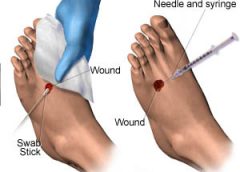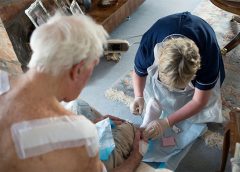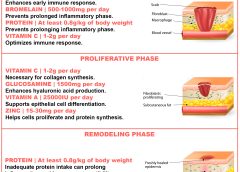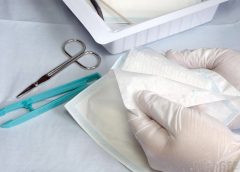http://www.sciencedaily.com/releases/2014/01/140124082600.htm
Read MoreSearch Results for: wound
Fifty shades of wound care at home
By Beth Hoffmire Heideman, MSN, BSN, RN, WCC, DWC, OMS
Fifty shades of wound care at home refers to treating the whole patient and the patient’s caregiving supporters—not just the wound. Only by understanding the nuances, or shades, of a patient and his or her environment can clinicians best achieve desired outcomes.
Wound healing in home care depends on teamwork. Members of the team must understand the unique situation of delivering care in the home and how to help patients adhere to the plan of care. (more…)
Read MoreQuality-improvement initiative: Classifying and documenting surgical wounds
By Jennifer Zinn, MSN, RN, CNS-BC, CNOR, and Vangela Swofford, BSN, RN, ASQ-CSSBB
For surgical patients, operative wound classification is crucial in predicting postoperative surgical site infections (SSIs) and associated risks. Information about a patient’s wound typically is collected by circulating registered nurses (RNs) and documented at the end of every surgical procedure. (more…)
Read MoreWhen and how to culture a chronic wound
By Marcia Spear, DNP, ACNP-BC, CWS, CPSN
Chronic wound infections are a significant healthcare burden, contributing to increased morbidity and mortality, prolonged hospitalization, limb loss, and higher medical costs. What’s more, they pose a potential sepsis risk for patients. For wound care providers, the goal is to eliminate the infection before these consequences arise.
Most chronic wounds are colonized by polymicrobial aerobic-anaerobic microflora. However, practitioners continue to debate whether wound cultures are relevant. Typically, chronic wounds aren’t cultured unless the patient has signs and symptoms of infection, which vary depending on whether the wound is acute or chronic. (See Differentiating acute and chronic wounds.) (more…)
Read MoreResearchers Explain Why Some Wound Infections Become Chronic
Wound Healing Market worth $22,142 Million by 2016
How do you prove a wound was unavoidable?
By Jeri Lundgren, BSN, RN, PHN, CWS, CWCN
A pressure ulcer that a patient acquires in your facility or a patient’s existing pressure ulcer that worsens puts your organization at risk for regulatory citations as well as litigation. Unless you can prove the pressure ulcer was unavoidable, you could find yourself burdened with citations or fines, or could even end up in court. (more…)
Read MoreHow dietary protein intake promotes wound healing
By Nancy Collins, PhD, RD, LD/N, FAPWCA, and Allison Schnitzer
Nutrition is a critical factor in the wound healing process, with adequate protein intake essential to the successful healing of a wound. Patients with both chronic and acute wounds, such as postsurgical wounds or pressure ulcers, require an increased amount of protein to ensure complete and timely healing of their wounds.
Elderly patients with wounds pose a special challenge because of their decreased lean body mass and the likelihood of chronic illnesses and insufficient dietary protein intake. To promote a full recovery, wound care clinicians must address the increased protein needs of wound patients, especially elderly patients. (more…)
Read MoreWound Management Technologies Receives Additional Funding from Brookhaven Medical Inc.; Expands Executive Team
Scientists Discover Important Wound-Healing Process
What you need to know about collagen wound dressings
By Nancy Morgan, RN, BSN, MBA, WOC, WCC, DWC, OMS
Description
Collagen, the protein that gives the skin its tensile strength, plays a key role
in each phase of wound healing. It attracts cells, such as fibroblasts and keratinocytes, to the wound, which encourages debridement, angiogenesis, and reepithelialization. In addition, collagen provides a natural scaffold or substrate for new tissue growth. (more…)
Clinical Notes: Debridement, Optimal Wound Healing, Diabetes, Sacral Wounds
Frequent debridement improves wound healing
A study in JAMA Dermatology reports that frequent debridements speed wound healing.
“The more frequent the debridement, the better the healing outcome,” concludes “Frequency of debridements and time to heal: A retrospective cohort study of 312 744 wounds.” The median number of debridements was two.
Most of the wounds in the 154,644 patients were diabetic foot ulcers, venous leg ulcers, and pressure ulcers. The study authors note that debridement is a “key process” in wound bed preparation and starting the healing process.
The findings are congruent with previous studies and are based on an analysis of the largest wound data set to date. (more…)
Read More



